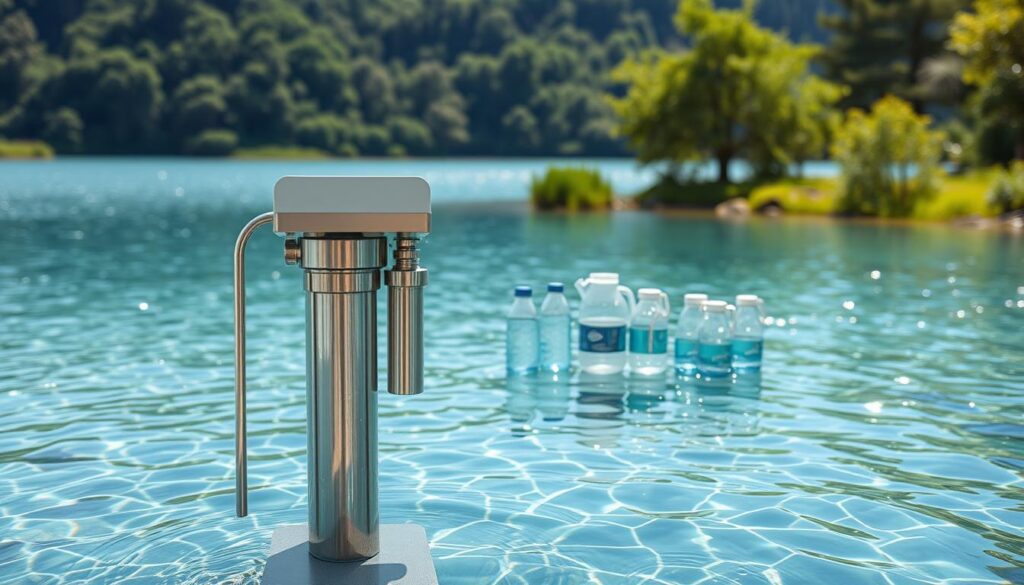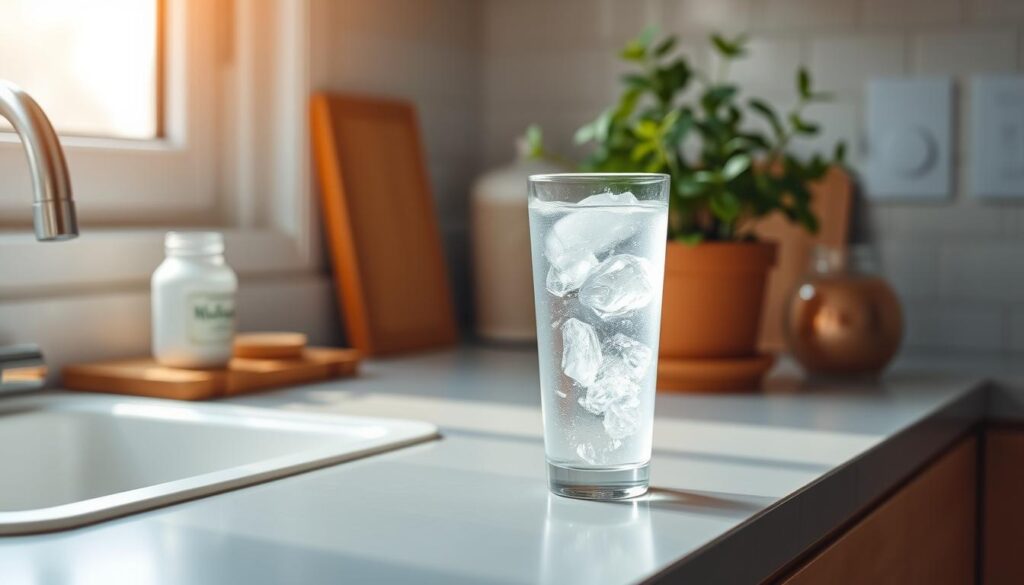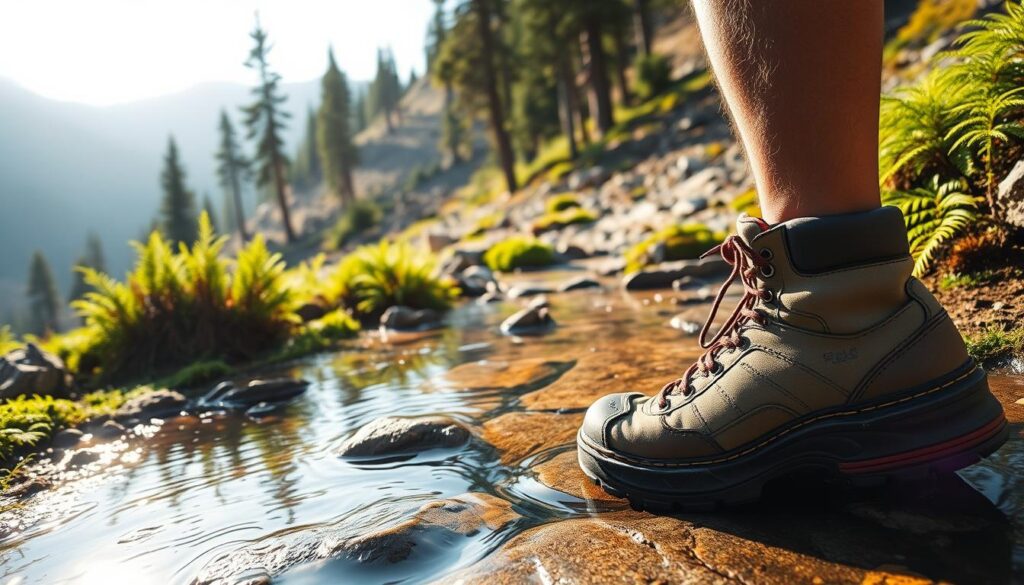As a parent, keeping your family healthy is top priority. Having clean water solutions is key to a healthy lifestyle. I’ve learned that drinking plenty of good, clean water is vital for a healthy body.
Having clean water at home is more than a convenience; it’s essential. In this guide, I’ll show you why safe drinking water options are important. I’ll also share practical tips to ensure your family has the cleanest water.
Key Takeaways
- Understanding the importance of clean water for family health
- Exploring available clean water solutions
- Learning how to implement safe drinking water options at home
- Discovering the benefits of having clean drinking water
- Identifying the best practices for maintaining clean water
Understanding the Importance of Safe Drinking Water
Knowing the importance of safe drinking water is key to keeping my family healthy. It’s vital for our health and can’t be ignored.
What Is Safe Drinking Water?
Safe drinking water has no harmful contaminants like bacteria, viruses, or chemicals. The World Health Organization (WHO) says it’s a basic human right. Having access to it is essential for our health.
Why It Matters for Health
Drinking safe water is critical for our health. Bad water can cause many health problems, like stomach issues and even brain damage. It’s important to use safe water for cleaning and cooking.
Safe drinking water offers many health benefits. It:
- Reduces the risk of waterborne diseases
- Supports overall health and well-being
- Prevents reproductive and developmental issues
The Consequences of Contaminated Water
Drinking contaminated water can be very harmful. It can cause serious illnesses like cholera and typhoid. Long-term use can even lead to cancer and brain damage.
| Contaminant | Health Risk |
|---|---|
| Bacteria (e.g., E. coli) | Gastrointestinal illness |
| Viruses (e.g., Rotavirus) | Gastrointestinal illness |
| Chemicals (e.g., Lead) | Neurological damage, developmental issues |
To avoid these risks, we need to use reliable water treatment options and best water purification methods. This way, we can ensure safe drinking water for our health and well-being.
Common Sources of Drinking Water
Drinking water comes from many places. You might get it from tap water, bottled water, well water, or even rainwater. Each source has its own safety concerns.
Tap Water: Is It Safe?
Tap water is common in many homes. In the U.S., the Environmental Protection Agency (EPA) checks its quality. Water suppliers must share annual reports on their water’s safety.
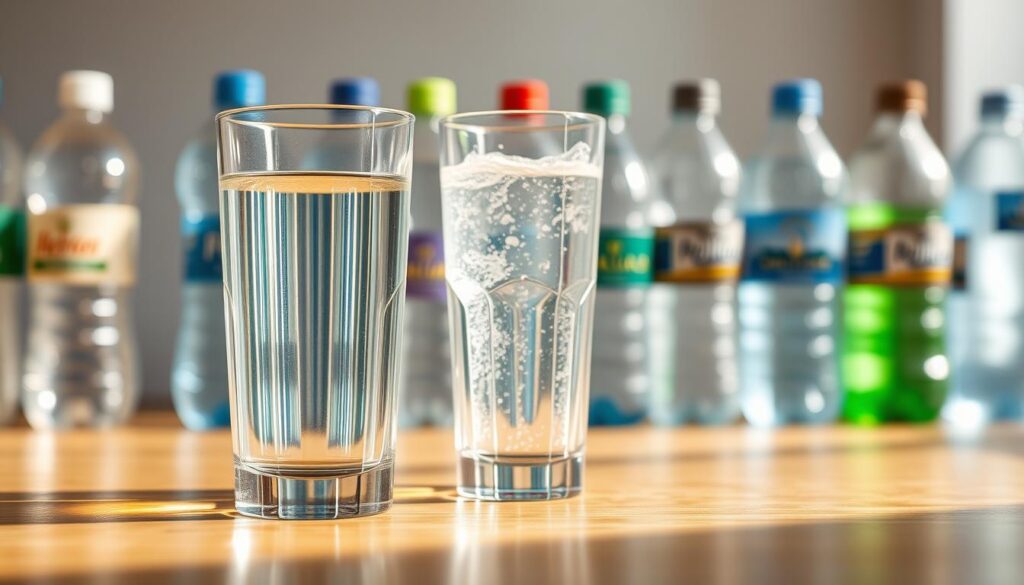
Bottled Water: Pros and Cons
Bottled water is popular for its convenience and purity. But, bottled water companies don’t always share their water quality tests. Look for brands that do.
Using affordable water filtration systems at home can save money and reduce plastic waste.
Well Water: Testing for Safety
Well water is common in rural areas. But, its safety depends on the well’s location and construction. Testing well water yearly is key to ensure it’s safe.
Rainwater Harvesting: An Alternative?
Rainwater harvesting is becoming more popular. It’s a sustainable way to get drinking water. But, you need to use proper collection and filtration systems to make it safe. Top-rated water filtration technologies can help.
| Water Source | Safety Concerns | Recommended Precautions |
|---|---|---|
| Tap Water | Contaminants, infrastructure issues | Read annual water quality reports |
| Bottled Water | Lack of transparency, quality variability | Choose brands with transparent testing |
| Well Water | Bacteria, nitrates, other contaminants | Regular testing for contaminants |
| Rainwater Harvesting | Collection and filtration system quality | Use top-rated filtration systems |
In conclusion, knowing where your drinking water comes from is key. Whether it’s tap water, bottled water, well water, or rainwater, being informed and taking precautions can help keep your water safe.
Assessing Your Home's Water Quality
It’s important to know if your home’s water is safe. This is true whether you get water from the tap, a well, or somewhere else. Checking the water quality is key to keeping your family healthy.
Conducting Water Tests
To start, you need to test your water. This will show if there are any bad stuff in it. You should use a certified lab or a local service to get accurate results.
Key parameters to test include:
- Bacteria (e.g., E. coli, coliform)
- Heavy metals (e.g., lead, arsenic)
- Nitrates and nitrites
- pH levels
- Other contaminants specific to your area
If you have a well, testing it often is very important. Wells can get contaminated easily.
Reading Water Quality Reports
After testing, you need to understand the results. Water quality reports can be hard to read. But, knowing what to look for helps a lot.
When reviewing your report, pay attention to:
- The types of contaminants detected
- The concentration levels of these contaminants
- Comparisons to maximum allowable limits set by regulatory agencies
This info tells you if your water is safe. It also shows what you might need to do to make it better.
Identifying Contaminants
Knowing what’s in your water is key to picking the right effective water purifier choice. Different filters catch different bad stuff. For example, activated carbon filters get rid of chlorine and some organic stuff. But, reverse osmosis systems can take out more, like heavy metals.
When picking a purifier, think about an eco-friendly water purification system. These systems not only clean your water but also don’t harm the environment. They use green materials and save energy.
If you have a well, testing it often is a must. Choose a filter that’s certified to remove what’s in your water. This way, you can make sure your water is safe and healthy for your family.
Filtration Systems: Finding the Right One
Advanced water filtration techniques make it easy to get safe drinking water at home. With many options, it’s key to know the different types, their features, and cost-effectiveness.
Types of Water Filters
There are many water filters, each with its own benefits. Carbon filters are affordable and good at removing common contaminants. They come in pitcher form or tap-mounted.
Reverse osmosis filters are a top choice for those willing to invest. Other options include ultraviolet (UV) light filters for killing bacteria and viruses. Distillation systems boil and condense water to remove many contaminants.
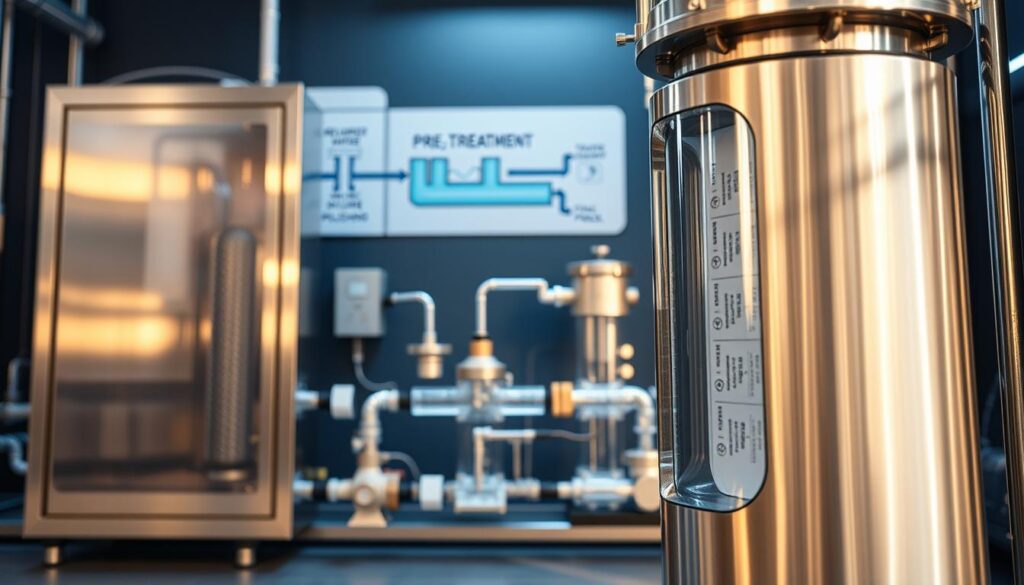
Key Features to Consider
When picking a water filter, consider a few key features. First, think about what contaminants it can remove. Some filters target specific impurities like lead or chlorine, while others tackle a wider range.
Also, think about the filter’s upkeep. Some need frequent replacement, while others can be cleaned and reused. The cost and ease of maintenance are important factors.
- Effectiveness against various contaminants
- Maintenance requirements
- Cost of replacement filters
- Certification by reputable third-party organizations
Cost vs. Benefit Analysis
Do a cost-benefit analysis when choosing a water filter. Some systems might cost more upfront but save money and perform better in the long run.
For example, a reverse osmosis system might be pricier to buy and maintain than a carbon filter. Yet, it can filter out more contaminants, leading to better health and cost savings on healthcare.
| Filter Type | Initial Cost | Maintenance Cost | Effectiveness |
|---|---|---|---|
| Carbon Filter | Low | Medium | Good |
| Reverse Osmosis | High | Medium | Excellent |
| UV Light Filter | Medium | Low | Excellent against microbes |
Boiling Water: A Simple Solution
Boiling water is a simple and reliable way to make water safe to drink. It has been used for centuries. This method is effective against many contaminants, making it a good choice for safe drinking water.
Effectiveness Against Contaminants
Boiling water kills pathogens like bacteria, viruses, and protozoa. By boiling water until it rolls, you can lower the risk of waterborne illnesses. If the water is cloudy, let it settle first. Then, skim the clean water above the sediment before boiling.
Key contaminants affected by boiling:
- Bacteria: Boiling kills bacteria like E. coli and Salmonella.
- Viruses: Boiling is effective against viruses such as Rotavirus and Norovirus.
- Protozoa: Boiling eliminates protozoa, including Giardia and Cryptosporidium.
Limitations of Boiling Water
Boiling is good against biological contaminants but has limits. It doesn’t remove chemical contaminants or heavy metals. Also, boiling needs a heat source and uses a lot of energy.
Considerations for boiling water:
| Aspect | Boiling Water |
|---|---|
| Effectiveness against biological contaminants | Highly effective |
| Removal of chemical contaminants | Not effective |
| Energy requirement | High |
When to Use This Method
Boiling water is great in emergencies or when traveling to areas with bad water. It’s also a good short-term fix until a better solution is found.
Scenarios for boiling water:
- During natural disasters or emergencies.
- When traveling to areas with poor water quality.
- As a temporary measure until a more permanent solution is available.
Chemical Treatment Options
Chemicals can make drinking water safe. They are great for emergencies or when you can’t use filters or boil water.
Chemicals like chlorine or iodine kill harmful germs in water. Reliable water treatment options are key for staying healthy, and chemicals work well in many situations.
Chlorine vs. Iodine
Chlorine and iodine are common for purifying water. Chlorine, found in bleach, fights many germs. Iodine, in tincture form, is good against bacteria and viruses.
Choosing between chlorine and iodine depends on a few things:
- Effectiveness: Both work well, but chlorine dioxide is known for its wide range of effectiveness.
- Safety: Both are safe if used right, but always follow the dosage to avoid health issues.
- Taste and Smell: Chlorine can taste or smell bad. Iodine might taste different, but less so than chlorine.
Using Water Purification Tablets
Water purification tablets are easy to use. They contain chlorine or iodine. Just drop the tablet in water, wait, and it’s ready to drink.
These tablets are great for travelers, campers, or emergency kits. Just remember to use them as directed.
How to Choose the Right Chemicals
Choosing the right chemicals depends on several things. Consider the contaminants, the amount of water, and your preferences.
- Think about the contaminants you need to remove. For example, chlorine dioxide fights Cryptosporidium.
- Always follow the product instructions for the right amount to use.
- Know any health risks from the chemical, like allergies or interactions.
Understanding chemical treatment options helps you make the best choice for your needs.
Understanding Water pH Levels
Exploring clean water solutions, the role of water pH levels is clear. The pH of drinking water shows its acidity or alkalinity. This greatly affects its safety and quality.
The Basics of pH
pH stands for “hydrogen’s power,” measured from 0 to 14. A pH of 7 is neutral. Values below 7 are acidic, and above 7 are alkaline. Understanding pH is key for water’s taste, quality, and safety.
Effects of High or Low pH
Water that’s too acidic or alkaline can harm health and plumbing. Acidic water can corrode pipes, releasing harmful metals. Alkaline water can cause scaling, affecting taste and possibly leading to kidney stones. Eco-friendly water purification systems often fix these issues by adjusting pH to a safe level.
Adjusting pH Levels
There are many ways to adjust water pH, like using filters. Filters can add minerals to raise pH or remove them to lower it. Choosing the right method depends on the water’s pH and the desired outcome. For those looking for clean water solutions, knowing these options is essential.
In summary, managing water pH levels is critical for safe drinking water. By understanding pH and how to adjust it, people can ensure eco-friendly and safe drinking water for their families.
Sustainable Water Practices
Practicing sustainable water use is good for the planet and my family’s health. It helps reduce our water usage and keeps our drinking water clean.
Rainwater Collection Techniques
Rainwater harvesting is a key sustainable practice. It collects and stores rainwater for tasks like watering plants or washing cars. Rainwater collection systems can be simple or complex, depending on the use and area size.
A basic system uses a large barrel under a downspout. More advanced setups include multiple tanks and filters, making the water safe for drinking.
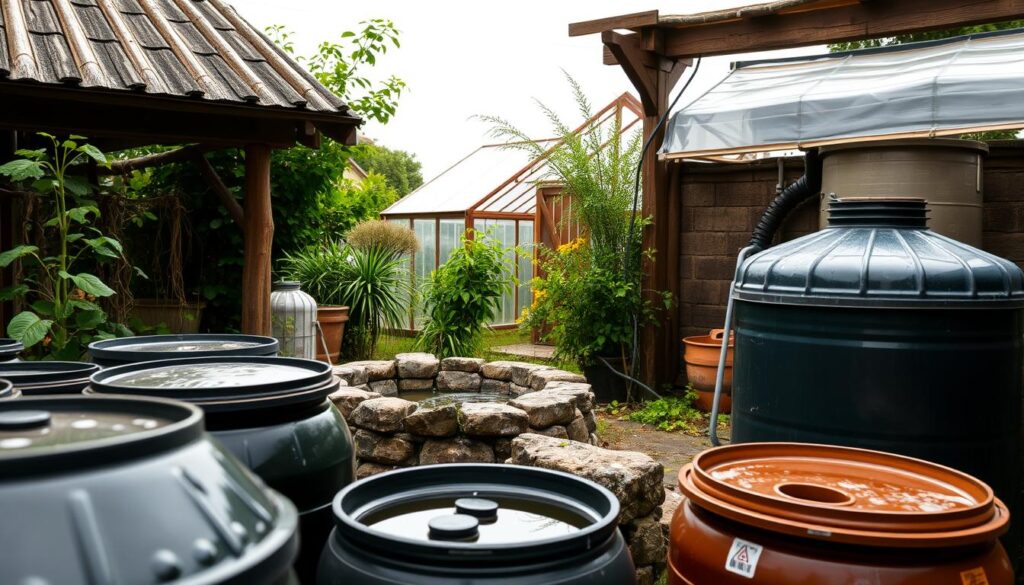
Reducing Water Waste
Less water waste is vital for sustainability. Simple steps like fixing leaks and using low-flow fixtures help a lot. For example, turning off the tap while brushing teeth saves a lot of water.
Using affordable water filtration systems also helps. It makes it safe to reuse water for things like irrigation and toilet flushing.
Community Resources for Safe Water
Getting safe drinking water is a team effort. Communities offer resources and programs to improve water quality. These include workshops on rainwater harvesting and subsidies for top-rated water filtration technologies.
| Community Resource | Description | Benefit |
|---|---|---|
| Workshops on Rainwater Harvesting | Educational sessions on setting up rainwater collection systems. | Encourages water conservation and reduces reliance on municipal water. |
| Subsidies for Water Filtration Systems | Financial assistance for households to install water filtration systems. | Makes safe drinking water more accessible and affordable. |
| Local Water Source Protection | Initiatives to protect rivers, lakes, and groundwater from pollution. | Ensures long-term sustainability of water resources. |
By using these community resources and adopting sustainable practices, I help the environment. I also ensure my family has safe, reliable drinking water.
Government Regulations on Water Safety
Government rules are key to keeping our drinking water safe. These rules help protect our health by making sure water is clean.
The EPA (Environmental Protection Agency) sets national water standards in the U.S. Their guidelines help keep water safe by limiting harmful substances.
EPA Guidelines and Standards
The EPA has strict rules for drinking water. The Safe Drinking Water Act lets the EPA set health-based standards.
Some important EPA rules include:
- Setting limits on harmful substances in water
- Requiring regular checks for contaminants
- Checking if water utilities follow the rules
Local Water Quality Agencies
Local agencies are vital in checking water quality. They work with the EPA to make sure water is safe.
Local agencies do many important things, like:
| Agency Role | Description |
|---|---|
| Water Quality Monitoring | Testing water for harmful substances and sharing results |
| Compliance Enforcement | Making sure water meets EPA standards |
| Public Education | Telling people about water safety and how to stay safe |
How to File Complaints
If you think your water is not safe, you can complain. You can contact your local agency or the EPA. Here’s how:
- Talk to your water utility about the problem
- File a formal complaint with your state or local agency
- Call the EPA’s Safe Drinking Water Hotline for help
Knowing about these rules helps us get safe drinking water. It also keeps us updated on the latest water cleaning methods.
The Role of Community in Water Safety
Community is key in keeping water safe and healthy. It’s everyone’s job to make sure we all have clean drinking water. We all need to work together to make this happen.
One great way to help is by getting involved with local efforts. Many groups in our area work on making water better and teaching us how to use it safely. By joining these groups, we can help find problems and support good solutions.
Getting Involved with Local Efforts
There are many ways to help make water safer. We can help clean up our water sources or push for better water systems. By doing these things, we can really make a difference in our water quality.
Educating Others About Safe Water
Teaching others about safe water is very important. When we share what we know about best water purification methods, we help everyone stay healthy. This is a big step towards a better community.
Building Awareness
It’s important to spread the word about water safety. We can do this by hosting workshops, sharing info online, or just talking to our neighbors. Every little bit helps in making our community safer.
Together, we can make our community a safer, healthier place. This effort not only improves water safety but also brings us closer together. It shows we all care about each other’s well-being.
Safe Drinking Water During Emergencies
Emergencies can cut off our access to clean water. Being prepared is key. It’s vital to have safe drinking water ready during emergencies.
Preparing for Water Emergencies
To get ready for water emergencies, having a plan is essential. This plan should include effective water purifier choices. You might store water in safe containers or have a purification system ready.
Choosing eco-friendly water purification systems is a good idea. They work well and are good for the environment.
The American Red Cross suggests having one gallon of water per person per day. This water is for drinking, cooking, and staying clean. Always check this stored water for any contamination.
“In the wake of natural disasters, access to safe drinking water is critical. Boiling water and using water purification tablets are effective methods during emergencies.”
Best Practices for Emergency Situations
In emergencies, it’s important to follow the best practices for safe drinking water. Boiling water is a simple and effective way to purify it. If boiling isn’t possible, water purification tablets or filters are good alternatives.
| Method | Effectiveness | Ease of Use |
|---|---|---|
| Boiling | High | Moderate |
| Water Purification Tablets | High | Easy |
| Water Filters | Moderate to High | Moderate |
Resources for Emergency Aid
For emergency help, many resources are available. Local and national emergency agencies often provide aid, including safe drinking water. Keep a list of emergency numbers and resources handy.
Being prepared and knowing how to get safe drinking water in emergencies can greatly reduce health risks. Contaminated water can be dangerous.
Encouraging Quality and Equity in Water Access
Everyone should have access to safe and clean drinking water. This is a matter of fairness and public health. Having safe drinking water options is key for families.
We need to make sure everyone gets clean water. We must address water quality issues and push for better water systems.
Universal Access to Clean Water
Safe drinking water is a basic right. It’s vital to ensure everyone gets clean water, even in areas with poor water quality. This helps improve public health a lot.
Addressing Water Quality Disparities
Water quality issues hit hard on vulnerable groups. We need to invest in clean water solutions. This includes better filters and upgrading water systems.
Doing this improves life quality and ensures safe drinking water for all.
Advocating for Better Infrastructure
It’s important to push for better water systems. Supporting efforts to improve water treatment and distribution helps make water access fair for all. Let’s all work together to promote safe drinking water and support policies for universal access.
FAQ
What is considered safe drinking water?
Safe drinking water has no harmful contaminants. It meets EPA standards. This means it’s free from bacteria, viruses, and chemicals.
How can I test the quality of my tap water?
You can test your tap water by contacting your local water utility. Or, use a certified lab. You can also use a home water testing kit.
What are the benefits of using a water filtration system?
A water filtration system removes contaminants. It improves taste and odor. It’s a good investment for a reliable source of safe drinking water.
Is boiling water enough to make it safe to drink?
Boiling water kills many contaminants. But, it might not remove all chemicals or heavy metals. It’s important to know its limits.
What are the differences between chlorine and iodine for water treatment?
Chlorine and iodine are both disinfectants. They work differently against various contaminants. The choice depends on your specific needs.
How do I know if my drinking water has the right pH level?
Use a pH test kit to check your water’s pH level. Adjust it if needed. The safe range is between 6.5 and 8.5.
Can rainwater harvesting be a reliable source of drinking water?
Rainwater harvesting can be a good alternative. But, it needs proper collection, storage, and treatment. This ensures its safety.
What are some effective ways to reduce water waste?
Reduce water waste by fixing leaks and using low-flow fixtures. Be mindful of your water usage habits too.
How can I get involved in local efforts to ensure safe drinking water?
Volunteer with local organizations and participate in community events. Advocate for policies that support safe drinking water initiatives.
What should I do during a water emergency?
Have a plan for water emergencies. This includes an emergency water supply and following local authorities’ guidance.
How can I advocate for better water infrastructure in my community?
Contact local officials and participate in public meetings. Support organizations that improve water infrastructure.
What are some affordable water filtration systems available?
Affordable options include pitcher filters, faucet-mounted filters, and under-sink systems. They’re effective and budget-friendly.
How can I ensure access to safe drinking water for everyone in my community?
Ensure safe drinking water access through education and community engagement. Advocate for policies that support clean water for all.

